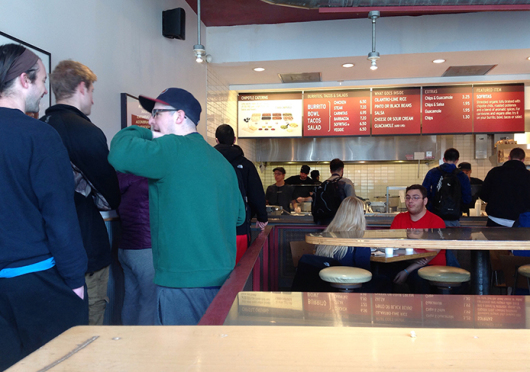
People stand in line at Chipotle, located at 1726 N. High St.
Credit: Alaina Bartel / Lantern reporter
Letter to the editor:
Many of you reading this have stood in line at Chipotle Mexican Grill. We know that its lines are notably long and somewhat intimidating. But how can these long lines act as such vivid metaphors for the state of inequality in our “equal opportunity” American society?
The people at the front of the line who are close to getting, or have their burrito already, get cold when the doors are opened and a breeze rolls in. The breeze rolls in because the line stretches out the door and some waiting for a burrito in the back of the line are forced to stand outside.
The problems here are that because the line is so long, both the front of the line gets chilly from the breeze that rolls in, and the people in the back of the line are the front lines against the cold, suffering even more than the front of the line.
The front of the line now has two routes of action that could remedy this problem: First, it could scrunch closer together in the front and encourage the middle to follow suit, making room for everyone to stand indoors but losing a small amount of its respective personal space; second, the front of the line could continue to stand in front with no thought of adapting for the benefit of the whole line, because they are already being served or will be served imminently.
Only the first route of action would address the problem of the whole as well as the front’s vested interest to stop being cold from the incoming breeze.
Obviously in this micro-example, you can see the very front of the line where you receive a burrito represents success in America by acceptable means, or as some would call it, the “American Dream.” The relative front of the line represents the American elite, economically and socially. The back of the line represents low-income Americans struggling just to get out of the cold, where the inconceivable “American Dream” is the least of their worries. Everyone else in this line represents the American middle class.
This hypothetical situation in the line at Chipotle gives all the power to the front of the line to be as positively influential or as nonchalant toward societal headway as they want. The middle of the line has limited but burdensome choices, and the back of the line is left at the mercy of the rest, simply present, but in no way a player.
It is worth noting that the difference between a Chipotle line and real American class mobility is that in the Chipotle line, it is abundantly easier to move in the desired direction. Unfortunately, other than that key difference, this situation mirrors American society quite well.
So next time you are in line for your burrito, remember that a lot of micros can make a macro, and everyone wants a burrito.
Clayton Sharb
Second-year in political science
[email protected]


